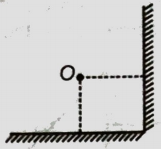An object is at a distance of \(30\) cm in front of a concave mirror of focal length \(10\) cm. The image of the object will be:
1.
smaller in size.
2.
inverted.
3.
between the focus and centre of curvature.
4.
All of the above.
| 1. | \(53^{\circ}\) | 2. | \(37^{\circ}\) |
| 3. | \(45^{\circ}\) | 4. | \(60^{\circ}\) |
In normal adjustment, the angular magnification of an astronomical telescope is 39. If the length of the tube is 2 m, then the focal length of the objective and eyepiece are respectively,
(1) 195 cm, 5 cm
(2) 190 cm, 10 cm
(3) 20 cm, 180 cm
(4) 10 cm, 190 cm
The following diagram shows a glass sphere of radius 10 cm with a paraxial incident ray. The refractive index of the material of the glass is

1. 2
2. 1.5
3. 1.75
4. 1.3
A convex lens of focal length 10 cm form real image of an object. The distance between the object and the image may be:
(1) 25 cm
(2) 30 cm
(3) 38 cm
(4) 50 cm
| 1. | \(45\) cm | 2. | \(30\) cm |
| 3. | \(15\) cm | 4. | \(25\) cm |
| 1. | \(X+Y\) | 2. | \(\dfrac{X +Y}{2}\) |
| 3. | \(X-Y\) | 4. | \(\dfrac{X -Y}{2}\) |
Two plane mirrors are placed perpendicular to each other as shown in the figure. An object O is kept at the angular bisector of the two mirrors. Numbers of images of object O is formed, will be:

1. 4
2. 3
3. 2
4. 1
Two convex lenses of focal lengths 10 cm and 30 cm are kept at a separation of 20 cm. Then the correct statement is:
(1) The effective focal length is 15 cm
(2) Chromatic aberration is minimized
(3) Combination behaves like a convergent lens
(4) All of these
If one surface of a biconvex lens is silvered, then it behaves as
(1) A concave mirror of focal length
(2) A concave mirror of focal length
(3) A convex mirror of focal length
(4) A concave mirror of focal length






